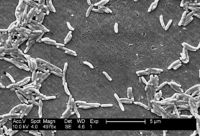Difference between revisions of "Campylobacter fetus subspecies fetus"
m (Text replace - "Category:To_Do_-_AimeeHicks" to "") |
|||
| (10 intermediate revisions by 2 users not shown) | |||
| Line 1: | Line 1: | ||
| − | {{ | + | {{review}} |
| − | Also known as: '''''C. fetus | + | |
| + | Also known as: '''''C. fetus''''' | ||
{{Taxobox | {{Taxobox | ||
| Line 8: | Line 9: | ||
|order =Campylobacterales | |order =Campylobacterales | ||
|family =Campylobacteraceae | |family =Campylobacteraceae | ||
| − | |genus = | + | |genus =Campylobacter |
|species =''C.fetus'' | |species =''C.fetus'' | ||
|Sub-species =''fetus'' | |Sub-species =''fetus'' | ||
}} | }} | ||
| − | + | [[File:campylo.jpg|thumb|200px|right|''Campylobacter fetus'' Janice Carr 2004, Wikimedia Commons]] | |
| − | [[File: | + | |
''Campylobacter fetus'', has the subspecies ''fetus'' and [[Campylobacter fetus subspecies venerealis|''venerealis'']], belonging to the genus [[Campylobacter species - Overview|''Campylobacter'']]. | ''Campylobacter fetus'', has the subspecies ''fetus'' and [[Campylobacter fetus subspecies venerealis|''venerealis'']], belonging to the genus [[Campylobacter species - Overview|''Campylobacter'']]. | ||
| − | + | ''C.fetus'' can cause sporadic abortion in cows and sheep and is the cause of 10% of ovine abortions in the UK. | |
| − | ''C. fetus'' is the cause of 10% of | + | The bacteria is an enteric organism of sheep, goats and cattle and is spread by faecal-oral transmission. The ingestion of ''C.fetus'' during last trimester of pregnancy causes a bacteraemia. |
| − | |||
| − | The bacteria is an enteric organism of sheep, goats and cattle and is spread by faecal-oral transmission. The ingestion of ''C. fetus'' during last trimester of pregnancy causes a bacteraemia. | ||
The bacteria can reach the uterus and necrotic placentitis causes late abortion, still birth or weak lambs. Aborted lambs may have round necrotic lesions on the surface of their liver. | The bacteria can reach the uterus and necrotic placentitis causes late abortion, still birth or weak lambs. Aborted lambs may have round necrotic lesions on the surface of their liver. | ||
Aborting ewes are therefore a source of infection for vulnerable animals and up to 20% of a flock may abort. | Aborting ewes are therefore a source of infection for vulnerable animals and up to 20% of a flock may abort. | ||
| − | + | A solid immunity may be developed. | |
| − | A solid immunity may be developed | ||
==Diagnosis== | ==Diagnosis== | ||
| − | The presence of ''C. fetus'' may be diagnosed by | + | The presence of ''C.fetus'' may be diagnosed by; hepatic lesions in lambs; the presence of organisms in the foetal abomasum and isolation and identification of the bacteria. |
| − | |||
| − | |||
| − | ==Treatment and | + | ==Treatment and control== |
The aborting ewes should be isolated and other ewes should be moved to clean pasture. The placenta should be destroyed and the flock vaccinated with bacterin during the outbreak and prophylactically. During and outbreak, chlortetracycline should be added to the feed. | The aborting ewes should be isolated and other ewes should be moved to clean pasture. The placenta should be destroyed and the flock vaccinated with bacterin during the outbreak and prophylactically. During and outbreak, chlortetracycline should be added to the feed. | ||
| + | ==Literature Search== | ||
| + | [[File:CABI logo.jpg|left|90px]] | ||
| − | |||
| − | |||
| − | |||
| + | Use these links to find recent scientific publications via CAB Abstracts (log in required unless accessing from a subscribing organisation). | ||
| + | <br><br><br> | ||
| + | [http://www.cabdirect.org/search.html?q=title%3A%28%22Campylobacter+fetus+fetus%22%29+OR+title%3A%28%22Campylobacter+fetus+subsp.+fetus%22%29+OR+title%3A%28%22Campylobacter+fetus+subspecies+fetus%22%29+ ''Campylobacter fetus'' subspecies ''fetus''] | ||
| + | [[Category:Campylobacter_species]] | ||
| − | |||
| − | [[Category: | + | [[Category:Expert_Review]] |
| − | |||
| − | |||
Revision as of 22:15, 9 October 2010
| This article has been peer reviewed but is awaiting expert review. If you would like to help with this, please see more information about expert reviewing. |
Also known as: C. fetus
| Campylobacter fetus | |
|---|---|
| Phylum | Proteobacteria |
| Class | Epsilon Proteobacteria |
| Order | Campylobacterales |
| Family | Campylobacteraceae |
| Genus | Campylobacter |
| Species | C.fetus |
Campylobacter fetus, has the subspecies fetus and venerealis, belonging to the genus Campylobacter. C.fetus can cause sporadic abortion in cows and sheep and is the cause of 10% of ovine abortions in the UK. The bacteria is an enteric organism of sheep, goats and cattle and is spread by faecal-oral transmission. The ingestion of C.fetus during last trimester of pregnancy causes a bacteraemia. The bacteria can reach the uterus and necrotic placentitis causes late abortion, still birth or weak lambs. Aborted lambs may have round necrotic lesions on the surface of their liver. Aborting ewes are therefore a source of infection for vulnerable animals and up to 20% of a flock may abort. A solid immunity may be developed.
Diagnosis
The presence of C.fetus may be diagnosed by; hepatic lesions in lambs; the presence of organisms in the foetal abomasum and isolation and identification of the bacteria.
Treatment and control
The aborting ewes should be isolated and other ewes should be moved to clean pasture. The placenta should be destroyed and the flock vaccinated with bacterin during the outbreak and prophylactically. During and outbreak, chlortetracycline should be added to the feed.
Literature Search
Use these links to find recent scientific publications via CAB Abstracts (log in required unless accessing from a subscribing organisation).
Campylobacter fetus subspecies fetus

